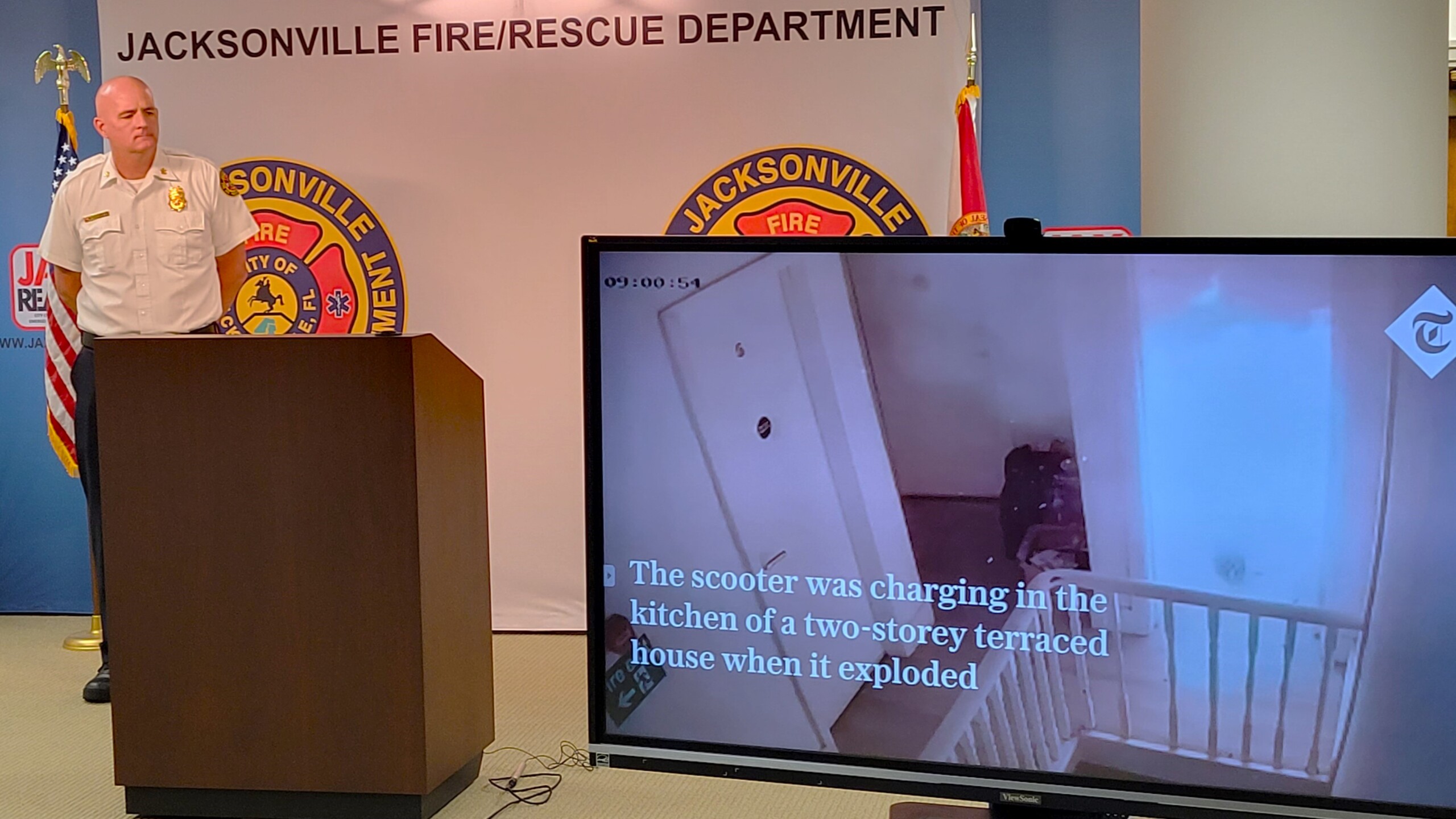It is called a “thermal runaway,” when the rechargeable lithium-ion battery in a cellphone, e-scooter or family car gets too hot, starts releasing poisonous gas, then burns — and burns.
As more people charge cellphones in hot cars in the sun this summer, or recharge an e-scooter in a hallway, battery fires could ignite, and “there’s no stopping it,” Jacksonville’s Chief of Safety Frank Gillis said.
Fire officials are seeing a growing number of fires in lithium-ion battery-powered devices, Chief Keith Powers said during a news conference Wednesday. Nothing available in the usual household will extinguish a lithium-ion battery fire, he said.
“If this happens with one of these batteries, you need not try to extinguish it because a normal fire extinguisher will not put it out. You need to get out of the structure that you are in and call 9-1-1 and let us come and handle it,” Powers said. “These batteries — when they go into thermal runaway, it is very rapid and very intense, so you won’t have time to get out of your house.”
Fire officials showed video after video Wednesday of e-scooters, rechargeable wheelchairs and other devices smoking, then exploding in bright flames.
“That smoke is what’s inflammable,” Gillis said. “It is also highly toxic. It has hydrogen fluoride in it. So the larger the battery, the more smoke, the more intense the fire.”

Lithium-ion batteries have been powering personal devices since the early 1990s, when they showed up in digital camcorders, according to research posted by the American Chemical Society. They may cause injury if they have design defects, are made of low-quality materials, are assembled incorrectly or are used or recharged improperly, according to the Occupational Safety and Health Administration.
In 2018, the U.S. Consumer Product Safety Commission reported over 25,000 overheating or fire incidents involving more than 400 types of lithium battery-powered consumer products. Some batteries will overcharge if a charger is used that does not turn off when the battery is fully charged, it said. Workers who wear or handle lithium-powered devices or batteries are particularly at risk if the battery catches fire or explodes since it is close to the body, OSHA said.
The biggest cause of a lithium-ion battery fire is heat, Powers said. When the battery hits 140 to 160 degrees, like leaving a cellphone in a car with windows shut, that can cause them to overheat and burn. Aftermarket batteries bought for power tools also are a concern, he said.
“The rechargeable battery goes bad and you order this aftermarket battery not designed by the manufacturer of that tool,” he said. “Those aftermarket batteries are not UL rated, and what we are seeing throughout the country is these aftermarket batteries are the ones that are really causing the problem.”
A damaged battery is also susceptible to fires, Powers said. A battery could be failing if it starts smoking or hissing or starts getting hot while inside the device.
Recent instances with electric vehicle battery fires — as well as more fires from battery-powered devices — is the reason for Wednesday’s public warning, fire officials said. Then there was the fire April 25 at the Saft lithium-ion battery manufacturing plant in Cecil Commerce Center on the Westside.
Jacksonville firefighters spent hours battling that fire, which began when one of the 20,000-pound batteries in the plant caught fire at the Waterworks Street facility, and initial attempts to extinguish it with chemicals and special fire extinguishers did not work. That is when hazmat units poured water on nearby batteries to keep them cool, since heat released during cell failure can damage nearby cells, also causing a thermal runaway.
The best way to avoid overheating lithium-ion batteries that could catch fire or explode is to make sure they are only recharged when someone is watching them. Don’t recharge a device overnight when everyone is asleep, or leave them plugged in if no one is home, he said. And for larger items like rechargeable scooters, wheelchairs and bicycles, charge them outside and not in a hallway.
“Don’t put it by your front door or your back door,” Gilis said. “Always put it in a corner and try to put it away from other things that can catch fire. But do not put it in the path of an exit or hallway.”
Gillis also warned people about the dangers of e-cigarettes, whose batteries can overheat when in someone’s pocket or purse. That is when they catch fire, “and they can’t get their pants off or whatever fast enough,” he said.
Damaged or old batteries should not be disposed of in the garbage or city recycling bin. Instead, take it to a hazardous waste facility, such as the one at 2675 Commonwealth Ave. in Jacksonville.
9(MDEwNzczMDA2MDEzNTg3ODA1MTAzZjYxNg004))







